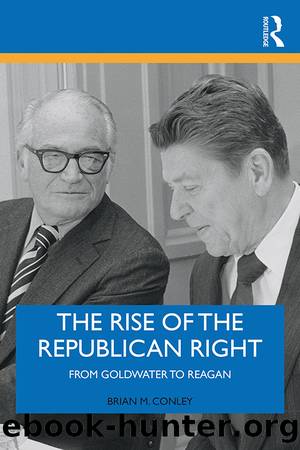The Rise of the Republican Right: From Goldwater to Reagan by Brian M Conley

Author:Brian M Conley [Conley, Brian M]
Language: eng
Format: epub
Tags: United States, Political Parties, Political Science, Political Process, History, General
ISBN: 9781351067119
Google: ywuWDwAAQBAJ
Goodreads: 45868901
Publisher: Routledge
Published: 2019-04-29T13:31:43+00:00
6
NIXON AND THE ORGANIZATIONAL INTERLUDE
Despite presidential prerogative, and the lack of a close personal relationship, Nixon worked quite closely with Bliss and the party in 1968. Nixonâs reasons for doing so were simple: he needed the party to win. There were many things, including voter registration, strong congressional campaigns, and a full-scale national voter mobilization program that would undoubtedly help Nixonâs candidacy, but that could not be undertaken by the campaign on its own. The campaign did not have the time or resources to perform each task, regardless of how crucial. It had to be done by the party, and preferably as soon as possible. Even financially, the new nominee was initially heavily dependent on the RNC, which had to advance the financially strapped campaign nearly a million dollars immediately after the Convention to kick-start the ambitious schedule of television ads Nixon had planned.
The election of Richard Nixon as president in 1968 was, unquestionably, a victory for the Republicans. It was the outcome that Bliss and the party leadership had soughtâhowever improbablyâsince the low days following Goldwaterâs sweeping 1964 loss. But Nixonâs win would also ultimately amount to a defeat for the party, specifically, the goal of building a more permanent national service party organization, as well as for the Conservative Right. The close collaboration between the party and the Nixon camp would prove instrumental to his narrow victory over Humphrey. But, once elected, Nixon moved swiftly to diminish the power of the party, by among other things, reshuffling its leadership, and nudging Bliss out. Blissâs departure marked the beginning of the end of not only the intensive, service-centered party-building that had consumed party affairs since the Goldwater loss, but also of the dominant influence such a system had afforded the partyâs conservative right. Once the center of power shifted to the White House, following the election, both the national service party infrastructure, and the power it granted the Right began to decline. The GOP became an âin-partyâ and was taken over by the prerogatives of a president rather than those of the party itself.
Indeed, the election demonstrated, quite starkly, the degree to which in-parties in the US function merely as appendages of the political and personal agenda of the president. Although, in the last quarter of the twentieth century, as Daniel Galvinâs (2009, p. 3) research highlights, Republican presidents were more likely than Democrat presidents to focus on party-building, they nonetheless did so for primarily âinstrumentalâ purposes, or as a means of promoting their own agenda. As president, Nixon governed largely based on his own ideas and organization, relying on the party only when and if it was expedient for him to do so.
The result was a dramatic and rapid decline in the overall organizational health of the party, but also, though much less significantly, in the influence the Right had exercised on the post-Goldwater Republican Party. However, the fallout from Nixonâs resignation in August 1974, with two years left in his second term, resulted not only in a
Download
This site does not store any files on its server. We only index and link to content provided by other sites. Please contact the content providers to delete copyright contents if any and email us, we'll remove relevant links or contents immediately.
The Secret History by Donna Tartt(18860)
The Social Justice Warrior Handbook by Lisa De Pasquale(12143)
Thirteen Reasons Why by Jay Asher(8800)
This Is How You Lose Her by Junot Diaz(6802)
Weapons of Math Destruction by Cathy O'Neil(6152)
Zero to One by Peter Thiel(5692)
Beartown by Fredrik Backman(5609)
The Myth of the Strong Leader by Archie Brown(5429)
The Fire Next Time by James Baldwin(5253)
How Democracies Die by Steven Levitsky & Daniel Ziblatt(5133)
Promise Me, Dad by Joe Biden(5089)
Stone's Rules by Roger Stone(5028)
A Higher Loyalty: Truth, Lies, and Leadership by James Comey(4851)
100 Deadly Skills by Clint Emerson(4845)
Rise and Kill First by Ronen Bergman(4705)
Secrecy World by Jake Bernstein(4652)
The David Icke Guide to the Global Conspiracy (and how to end it) by David Icke(4629)
The Farm by Tom Rob Smith(4442)
The Doomsday Machine by Daniel Ellsberg(4420)
